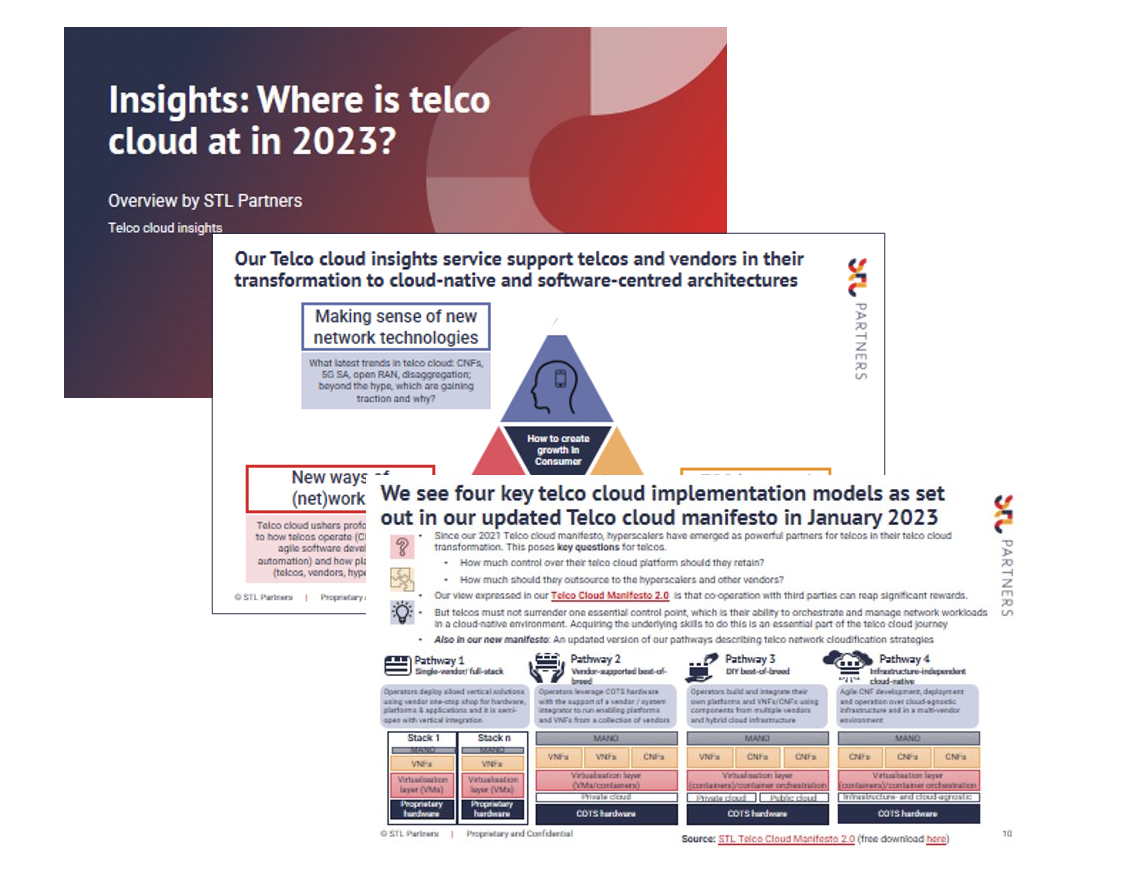
Progress in telco cloud: How do we measure agility?
In the January 2023 update to our Telco Cloud Deployment Tracker, which was looking back at the entirety of calendar year 2022, we recorded an overall slowdown in deployments. Physical milestones remain important, and there were fewer of those in 2022 than we and the industry had anticipated. But are we using the right measures to assess progress? As more (parts of the) networks become cloud-native, this frees operators from reliance on their own infrastructure. This also means that sheer volume of network assets deployed and number of new connectivity services launched are not the only measure for progress in telco cloud. Cloud-native networking requires new mindsets, skillsets and capacity for innovation, and – consequently – new success criteria. This is what this article explores.
As networks become cloud-native, launches have slowed
Cloudification and disaggregation of the telco network bring a need to think about network services in a different way: Networks become software-based artifacts that can be assembled, distributed and orchestrated on demand in support of different use cases and, in theory, over any cloud infrastructure.
This is what we mean by ‘virtual networks’: Logical constructs and architectures that regulate the flow of data and the distribution of workloads over any combination of virtual and physical network infrastructure – multi-domain, multi-vendor, multi-cloud, multi-protocol and multi-standard.
This transformation in the status and meaning of networks indirectly helps explain some of the industry-wide trends that we have been seeing in telco cloud, as we reported in the January 2023 update to the Telco Cloud Deployment Tracker. There were far fewer deployments overall in 2022 than in 2021. The main reason for this was a slowdown in previously announced or promised 5G SA and open RAN deployments:
Figure 1: Global telco cloud deployments, 2018 to 2023

The 5G SA core and open RAN are the first fully cloud-native network functions (CNFs) slated for deployment at scale across the telco macro network. As CNFs, the ultimate benefit that they have the potential to realise – and that they are designed to deliver – is flexible, on-demand deployment across multiple clouds and cloud locations, both centralised and edge. The purpose of this is to enable scalable, programmable and customisable connectivity for specific use cases and services, such as edge compute, IoT, Industry 4.0, vertical-specific services, private networks, etc.
But there are as yet few mature use cases that actually require all the capabilities that 5G SA and 5G open RAN have the potential to bring; nor is there yet any clear demand for them. Currently, most of the vertical-specific and private networking services that have been launched rely on other technologies, such as 4G, Wi-Fi, 5G NSA, and different forms of appliance-based RAN.
This has led operators to defer or scale back on their deployments of 5G SA and open RAN, as we have discussed in a recent 5G SA report and a November open RAN webinar. At the same time, though, there is still an expectation that operators will roll out these technologies commercially across their macro networks, to a greater or lesser extent; and they are adjudged to have fallen short when they fail to do so.
A change of mindset is needed
That negative assessment of the absence of expected deployments is itself shaped by traditional assumptions and criteria. According to these, what matters most are physical milestones, such as coverage, number of cell sites activated, number of edge data centres supporting distributed core and RAN workloads, and number or percentage of network functions that have been virtualised or were virtualised from the outset (i.e. cloud-native). In addition, the importance that is ascribed to these criteria is based on the degree to which the networks can support standard connectivity services, rather than the innovative, use case-specific services that represent the full potential of cloud-native networks. But those standard connectivity services are in any case arguably best served – for the time being, at least – by established, legacy RAN; although there are reasons other than pure network performance (e.g. supplier diversity, costs, energy efficiency, etc.) why open RAN has an important role to play in this context too.
So operators have at their disposal a powerful set of new technologies: Programmable, high-capacity and distributed workload processing (SA core); and scalable, open and programmable RAN (open RAN). But they are yet to fully develop the appropriate mindset, skillset or use cases either to deploy these to best effect or to evaluate those deployments. Their thinking and planning for these technologies– and the thinking of many industry watchers, including ourselves to some extent – is still shaped by the old world of physical networks and standard connectivity products. These place a supreme value on aspects of physical quantity and volume – e.g. number of particular assets deployed and volume of traffic supported – rather than qualitative measures around the agility and capacity for innovation that virtualisation helps to deliver. But what is more important than pure volume of telco cloud deployments – although that remains a key comparative measure – is the degree to which telcos become agile, innovative organisations able to deliver valuable use cases and services for customers, many of which will not in fact require the latest physical networking technologies or virtualised network functions such as the SA core and open RAN. The ability to innovate useful services is more important than deploying innovative technologies for their own sake.
But progress in cloud-native networking is being made – in the public cloud
By contrast, in the January 2023 update to the Tracker, we present some examples of telcos that are deploying SA core and open RAN on the hyperscale cloud: Exemplifying the new networking paradigm whereby network functions are no longer dependent purely on the telco’s own physical infrastructure. But crucially, not every part of the telco cloud stack is deployed and operated on the hyperscale cloud, just those parts of it that best help the telco to deploy rapidly and cost-effectively at scale and to skill up on cloud. Most crucially of all, the telcos involved have retained control over the development, operation and orchestration of their CNFs across their own and the hyperscalers’ infrastructure: a vital element in telcos’ move to multi-cloud.
What the examples we discuss show (AT&T, Bell Canada, DISH, Swisscom and Telenet ) is that the more CNFs are distributed and operated over a diverse array of virtual and physical infrastructure – parts of which telcos do not own – the more important it is for operators to develop the internal skills and processes to manage and evolve their network functions and services across this infrastructure. Deployment and operation of virtual networks across a multi-cloud goes hand in hand with becoming more skilled and competent at cloud networking: able to innovate and deliver at scale the ‘on demand’ network services that create value for clients and new value for the telco. It is not owned, physical facilities-based assets that matter the most, but virtual networking skills and functions that will ultimately enable services to be created and delivered across any cloud.
Read more about Telco cloud
Telco cloud insights pack
This document will provide you with the latest insights from our research and consulting work, including some extract of our Telco Cloud Manifesto 2.0, and our latest analysis on open RAN.
Network APIs: Unlocking new value in the telco cloud
Network APIs may offer an answer to the question of how to monetise recent and upcoming telco cloud deployments. Virtualised networks upgrade APIs and enhance the value they offer to developers and customers. To unlock their potential, telcos should focus on optimising their commercial models.
Network Innovation insights pack
This document will provide you with the latest insights from our research and consulting work, including some extract of our Telco Cloud Manifesto 2.0, our latest analysis on open RAN.
Core-as-a-Service since 2018: Wgtwo
Core-as-a-Service is not a brand new concept. Working Group Two, aka wgtwo – a smaller Scandinavian outfit, has been offering Core-as-a Service since 2018. We spoke to their CEO Erlend Prestgard about why wgtwo’s original mission to help telcos extract more value from connectivity remains as relevant in 2022.




